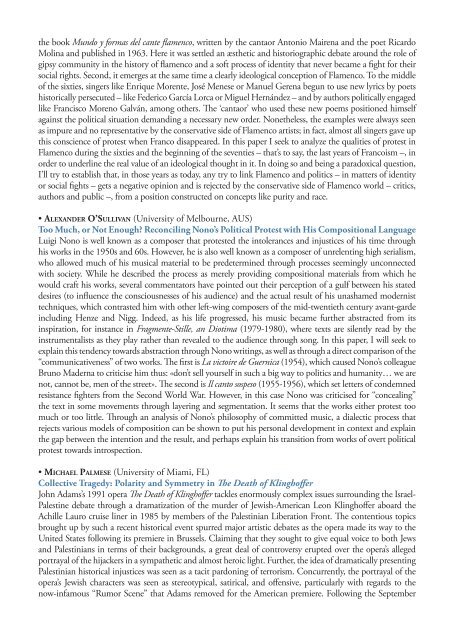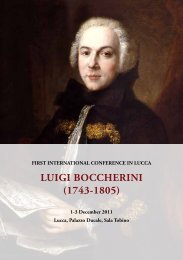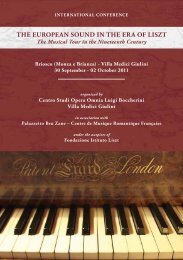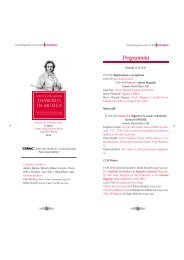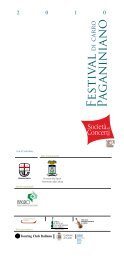PROGRAMME - Centro Studi Opera Omnia Luigi Boccherini
PROGRAMME - Centro Studi Opera Omnia Luigi Boccherini
PROGRAMME - Centro Studi Opera Omnia Luigi Boccherini
You also want an ePaper? Increase the reach of your titles
YUMPU automatically turns print PDFs into web optimized ePapers that Google loves.
the book Mundo y formas del cante flamenco, written by the cantaor Antonio Mairena and the poet RicardoMolina and published in 1963. Here it was settled an æsthetic and historiographic debate around the role ofgipsy community in the history of flamenco and a soft process of identity that never became a fight for theirsocial rights. Second, it emerges at the same time a clearly ideological conception of Flamenco. To the middleof the sixties, singers like Enrique Morente, José Menese or Manuel Gerena begun to use new lyrics by poetshistorically persecuted – like Federico García Lorca or Miguel Hernández – and by authors politically engagedlike Francisco Moreno Galván, among others. The ‘cantaor’ who used these new poems positioned himselfagainst the political situation demanding a necessary new order. Nonetheless, the examples were always seenas impure and no representative by the conservative side of Flamenco artists; in fact, almost all singers gave upthis conscience of protest when Franco disappeared. In this paper I seek to analyze the qualities of protest inFlamenco during the sixties and the beginning of the seventies – that’s to say, the last years of Francoism –, inorder to underline the real value of an ideological thought in it. In doing so and being a paradoxical question,I’ll try to establish that, in those years as today, any try to link Flamenco and politics – in matters of identityor social fights – gets a negative opinion and is rejected by the conservative side of Flamenco world – critics,authors and public –, from a position constructed on concepts like purity and race.• Alexander O’Sullivan (University of Melbourne, AUS)Too Much, or Not Enough? Reconciling Nono’s Political Protest with His Compositional Language<strong>Luigi</strong> Nono is well known as a composer that protested the intolerances and injustices of his time throughhis works in the 1950s and 60s. However, he is also well known as a composer of unrelenting high serialism,who allowed much of his musical material to be predetermined through processes seemingly unconnectedwith society. While he described the process as merely providing compositional materials from which hewould craft his works, several commentators have pointed out their perception of a gulf between his stateddesires (to influence the consciousnesses of his audience) and the actual result of his unashamed modernisttechniques, which contrasted him with other left-wing composers of the mid-twentieth century avant-gardeincluding Henze and Nigg. Indeed, as his life progressed, his music became further abstracted from itsinspiration, for instance in Fragmente-Stille, an Diotima (1979-1980), where texts are silently read by theinstrumentalists as they play rather than revealed to the audience through song. In this paper, I will seek toexplain this tendency towards abstraction through Nono writings, as well as through a direct comparison of the“communicativeness” of two works. The first is La victoire de Guernica (1954), which caused Nono’s colleagueBruno Maderna to criticise him thus: «don’t sell yourself in such a big way to politics and humanity… we arenot, cannot be, men of the street». The second is Il canto sospeso (1955-1956), which set letters of condemnedresistance fighters from the Second World War. However, in this case Nono was criticised for “concealing”the text in some movements through layering and segmentation. It seems that the works either protest toomuch or too little. Through an analysis of Nono’s philosophy of committed music, a dialectic process thatrejects various models of composition can be shown to put his personal development in context and explainthe gap between the intention and the result, and perhaps explain his transition from works of overt politicalprotest towards introspection.• Michael Palmese (University of Miami, FL)Collective Tragedy: Polarity and Symmetry in The Death of KlinghofferJohn Adams’s 1991 opera The Death of Klinghoffer tackles enormously complex issues surrounding the Israel-Palestine debate through a dramatization of the murder of Jewish-American Leon Klinghoffer aboard theAchille Lauro cruise liner in 1985 by members of the Palestinian Liberation Front. The contentious topicsbrought up by such a recent historical event spurred major artistic debates as the opera made its way to theUnited States following its premiere in Brussels. Claiming that they sought to give equal voice to both Jewsand Palestinians in terms of their backgrounds, a great deal of controversy erupted over the opera’s allegedportrayal of the hijackers in a sympathetic and almost heroic light. Further, the idea of dramatically presentingPalestinian historical injustices was seen as a tacit pardoning of terrorism. Concurrently, the portrayal of theopera’s Jewish characters was seen as stereotypical, satirical, and offensive, particularly with regards to thenow-infamous “Rumor Scene” that Adams removed for the American premiere. Following the September


